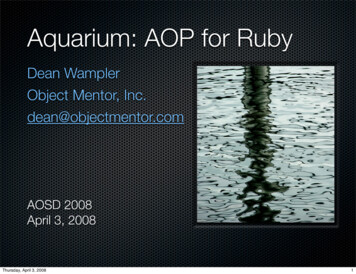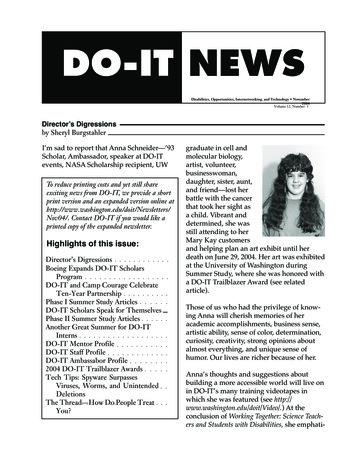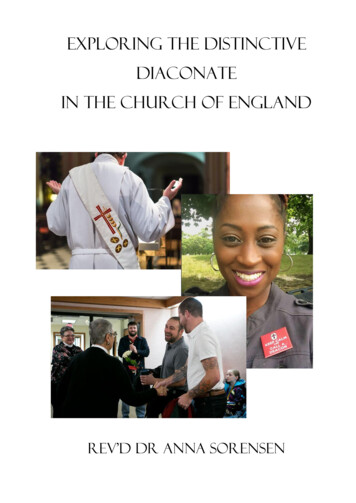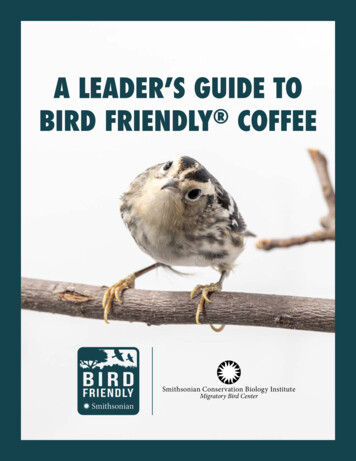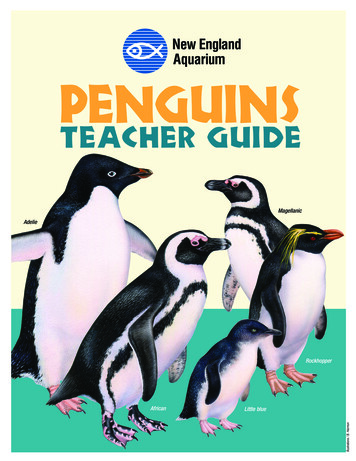
Transcription
PenguinsTeacher GuideMagellanicAdelieRockhopperLittle blueIllustrations / B. HarmonAfrican
Penguin Teacher GuideIntroductionPenguins are birds, and like other birds, they have wings and are covered with feathers.They lay eggs and are warm-blooded animals.Penguins evolved from the flying birds of more than 40 million years ago. The firstpenguin fossil fragments were found in New Zealand in the mid-1800s. To date, thediscovery of all penguin fossil fragments has been limited to the Southern Hemisphere.The closest living relatives to penguins are the albatrosses, shearwaters, petrels, loons andgrebes.The origin of the word penguin has been a subject of debate. Theories range fromreferences to the amount of fat penguins possesses (penguigo in Spanish and pinguis inLatin) to the claim that the word was derived from two Welsh words meaning “whitehead.” The most agreed-upon explanation is that penguin was used as a name for thenow-extinct great auk, which the modern-day penguin resembles and for which it wasmistaken.Scientific ClassificationKingdom: AnimaliaPhylum: ChordataClass: AvesOrder: SphenisciformesFamily: SpheniscidaeGenera: Aptenodytes, Eudyptes, Eudyptula, Megadyptes, Pygoscelis, SpheniscusDistribution and HabitatAll 17 species of penguins live in the Southern Hemisphere. Penguins generally live onislands and remote continental regions that are free of land predators, where theirinability to fly is not detrimental to their survival. Penguin species are found on everycontinent in the Southern Hemisphere. They are abundant on many temperate and subAntarctic islands. Different species thrive in varying climates, ranging from Galapagospenguins on tropical islands at the equator to emperor penguins restricted to the ice ofAntarctica.These highly specialized marine birds are adapted to living at sea. Some penguin speciesspend as much as 80% of their lives in the ocean. They usually are found near nutrientrich, cold-water currents that provide an abundant supply of food.Physical CharacteristicsThere are 17 different species of penguins, and they vary in size and shape. The emperorpenguin is the largest of all living penguins, standing at 4 feet and weighing 90 pounds.The smallest of the penguins is the little blue penguin, standing just 10 inches andweighing about 2.5 pounds.1
Everything about a penguin is fine-tuned for swimming. Their body is rounded in themiddle and pointed at either end, which is the perfect shape for sliding through water.Their powerful, flipper-like wings propel them through the ocean. Penguins are awkwardon land, but their short legs and webbed feet are the perfect rudder system underwater.And unlike other birds, penguins have solid bones. This added weight counteracts theirnatural buoyancy and helps them move quickly through water.Penguins use their torpedo-shaped body to shoot through water at speeds of 15 miles perhour or more. Some penguins leap into the air while swimming—a trick known asporpoising.Penguin legs are short and strong. Their feet are webbed, with visible claws. Penguinswalk with short steps or hops, sometimes using their bills or tails to assist themselves onsteep climbs. Some species, like the rockhopper, jump from rock to rock. Antarcticspecies can move much faster over ice by “tobogganing” on their bellies, using theirflippers and feet to help them move along.Their tuxedo-like black and white coloring is extremely effective camouflage—known ascountershading—which helps them hide from predators and prey in the open ocean. Forexample, if a shark or other predator swims below a penguin, the penguin’s white bellyblends in with the bright sunlight coming from above. Likewise, if a penguin swimsbelow some fish it wants to catch, its black back blends in with the dark depths of the sea.Different species of penguins can be identified by their head and facial markings.Penguins only eat seafood and swallow their food whole since they don’t have teeth.They use their powerful, hooked beaks to catch fish, squid and krill. Their tongues have arough, Velcro-like texture that helps them hold and swallow their slippery food. The NewEngland Aquarium’s 65 penguins eat nearly 600 pounds of sardine, capelin, smelt andherring every month. Most of them eat five to ten fishes every day.Like many animals, penguins have a nictitating membrane, sometimes called a thirdeyelid. This is a clear covering that protects the eye from injury.A penguin’s tail is short and wedge-shaped.Adelie, gentoo and chinstrap penguins (known asbrush-tailed penguins) have 14 to 18 stiff tailfeathers, which they often use as a prop when onland.Penguins have about 80 feathers per squareinch—more than any other bird. Penguins need allof those feathers to keep warm and dry. The fluffy down at the base of each feather trapsair near the penguin’s skin. This air layer helps penguins keep warm, even in cold air andfrigid water. When penguins are too warm, they fluff their feathers to release extra bodyheat.2
The outer tip of each feather is stiff and small. Every feather tip overlaps with thosearound it, like shingles on a roof. This is what keeps penguins dry in the ocean. The tipsof the feathers get wet, but the fluffy down stays dry and warm.Penguins replace their feathers, or molt, once a year. Every year during a two to threeweek period, they shed their feathers and grow a complete new set. This means penguinshave to keep their feathers healthy for a whole year. Because of this, most penguinsspend hours every day taking care of their feathers, a behavior known as grooming orpreening. A grooming penguin first cleans each feather, removing dirt and water. Then itconditions the feathers by spreading out oil from a gland at the base of its tail.Penguins are vulnerable to predators and cold temperaturesduring molting. The old feathers are no longer waterproof orinsulating and the bird cannot enter the ocean to catch food or toescape land predators. Because penguins fast during the moltingperiod, they must gorge themselves for a few weeks prior tomolting. They live off stored fat until new feathers grow in.SensesAs in most birds, penguin hearing is thought to be good.Vocalizations (calls) are important in communication and materecognition. Penguins have good vision both on land and under water, since they canchange the shape of their cornea. The sense of taste in penguins has not been extensivelystudied. In general, the sense of taste is poorly developed in birds. Penguins’ sense ofsmell may be more developed than early studies indicated since the olfactory lobe of apenguin’s brain is large.FoodPenguins only eat seafood and swallow their food whole since they don’t have teeth.They use their powerful, sharp beaks to catch fishes, squid and krill. Their tongues have arough, Velcro-like texture that—along with a hooked beak—helps them hold andswallow their slippery food. The New England Aquarium’s 65 penguins eat nearly 600pounds of sardine, capelin, smelt and herring every month. Most of them eat five to tenfishes every day.AdaptationsHow penguins stay warm and dry:The downy under portion of the feathers traps a layer of air against the skin. This layer ofair is then warmed by body heat, much the way our body heats the air in a down jacket.Their feathers overlap like shingles on a roof and form a barrier, keeping water awayfrom the skin. Penguins also have a layer of blubber, or fat, under the skin. As a rule,larger penguins live in colder areas. This is because larger, rounder bodies lose heatslower than smaller, slimmer bodies. This explains why Antarctica’s emperor penguins,which survive the harshest winters, are the largest penguins in the world.3
How penguins stay cool:Some penguin species have bare patches (heat windows) around their eyes. These areashave no feathers and allow excess heat to escape. The patches become very pink whenthe penguin is warm. Penguins can voluntarily raise their feathers to let the warm airescape. Penguins have many tiny blood vessels (capillaries) close to the skin on theirwings, which helps them to cool down by just holding their wings out and letting the airmove across them. Penguins can release heat through their feet, where they have acounter-current blood exchange system.How they swim:A streamlined body, webbed feet and oar-like wings enable penguins to shoot through thewater at speeds up to 15 miles per hour. It is often said that penguins look like they areflying through the water. Underwater quicknessand the ability to hold their breath aid penguins incatching prey. All penguins use their short, stiffwings for propulsion and their webbed feet forsteering. The position of their feet on the lowerpart the body aids in both steering andhydrodynamics.How they hide:As mentioned before, penguins have black backsand white bellies. This pattern of coloration iscalled countershading and serves to camouflage thebird when it is in the water. Since penguins spendmost of their time in the ocean, this coloration is an effective form of protection.Countershading also helps the penguins hunt with more success.How they dive deeper:Most birds have hollow bones, making them lighter for flying. Penguins, however, havesolid bones, making them heavier and making it easier to dive underwater for food.How they shake off the salt:Penguins have almond-shaped glands beneath the skin above their eyes that help themfilter out the excess salt from the ocean. The salt drips down their beak, the penguinsmake a sneeze-like sound, and they are able to shake it off.ReproductionMale and female penguins look alike, even to thetrained eye. Observing mating behavior, performingan internal examination, or doing DNA analysis arethe only ways to distinguish male from femalepenguins. The reproductive behaviors such as mating,courtship and nesting differ from species to species.The color, shape and size of eggs also differ.4
Penguin SpeciesAdeliePygoscelis adeliaeStanding height: 18-24 inchesWeight: 8-10 poundsHome: circumpolar on Antarctic continent and the surrounding waters within limitsof pack iceLower risk population estimated at 4,931,600 birdsThe Adelie penguin is the characteristic “tuxedo” penguin of Antarctica.This species, along with the emperor penguin, is restricted to Antarctica and thesurrounding waters.AfricanSpheniscus demersusStanding height: 25-27 inchesWeight: 6-8 poundsHome: South Africa and NamibiaVulnerable population estimated at 180,000 adultsAfrican penguins nest in burrows for protection from the hot sun and predators.They are referred to as jackass penguins since their vocalizations sound like brayingdonkeys.ChinstrapPygoscelis antarcticaStanding height: 28-30 inchesWeight: 8.5-9.5 poundsHome: Circumpolar, breeding south of the Antarctic convergence on islands and onthe Antarctic peninsulaLower risk population estimated at 15,000,000 birdsThe chinstrap penguin is the second-most numerous penguin in the world. Thispenguin belongs to a group of penguins known as the brush-tailed or stiff-tailedpenguins.EmperorAptenodytes forsteriStanding height: 36-44 inchesWeight: 60-90 poundsHome: Marine, circumpolar, within the Antarctic zone, approximately 40 coloniesscattered around Antarctica, most on fast iceLower risk population estimated at 436,200 birdsThe emperor penguin is the largest of all penguins. This penguin endures theharshest weather of any species on the planet.5
Erect crestedEudyptes sclateriStanding height: 25 inchesWeight: 6-7.7 poundsHome: Both islands of New Zealand, with some birds on Antipodes, Bounty andAuckland Islands. Non-breeding range at sea is unknown.Vulnerable population estimated at 330,000 birdsAll species of crested penguins have heads adorned with yellow feathers.FiordlandEudyptes pachyrhynchusStanding height: 24 inchesWeight: 6-7 poundsHome: sub-Antarctic islands and New ZealandVulnerable population estimated at 5,000-6,000 birdsThe Fiordland penguin is considered the most timid and the most rare of the crestedpenguins.GalapagosSpheniscus mendiculusStanding height: 21 inchesWeight: 5-6 poundsHome: Lives year-round on the Galapagos Islands of Fernandina and Isabela,600 miles west of EcuadorEndangered population estimated between 3,000 and 8,000 birdsThis penguin is a truly tropical weather penguin, living on the hot desert islands ofthe Galapagos at the equator—making it the most northerly penguin species.Temperatures often exceed 100 degrees in this region.GentooPygoscelis papuaStanding height: 30-35 inchesWeight: 10-14 poundsHome: Around the globe on sub-Antarctic islands and the Antarctic peninsulaLower risk population estimated at 628,000 birdsThe gentoo penguin belongs to a group of penguins commonly known as brush-tailedpenguins, which also include the Adelie and chinstrap penguins. The gentoo is themost timid of the three.HumboldtSpheniscus humboldtiStanding height: 18-24 inchesWeight: 6-11 poundsHome: The western coast of South America (Peru and Chile). Although the airtemperature can be warm, the water of the Humboldt current is very cold.Vulnerable population estimated at 13,000 birdsThe Humboldt penguin populations have declined seriously during the past centurydue to many factors, including loss of good nesting sites, reduced food supply,predation and the impact of increasingly severe El Niño fluctuations. Biologists areworking toward their conservation.6
KingAptenodytes patagonicusStanding height: 37 inchesWeight: 30-45 poundsHome: sub-Antarctic and Antarctic islandsLower risk population estimated at 3,276,890 birdsThe king penguin is the second largest of all penguins. They are gregarious bynature, gathering in colonies by the thousands. Kings are found in their coloniesyear round because it takes them 15-18 months to raise their single chick.Little blueEudyptula minorStanding height: 10-12 inchesWeight: 2-3 poundsHome: Australia and New Zealand. The inshore habits of this species have causedisolated groups to evolve into 6 recognized subspecies.Stable population estimated at 700,000-1,200,000 birds.The little blue penguin is the smallest species of penguin in the world and is foundexclusively in Australia and New Zealand. This penguin employs a wide range ofsongs more extensively than any other penguin species. From an evolutionarystandpoint, the little penguin is also considered the most primitive.MacaroniEudyptes chrysolophusStanding height: 28 inchesWeight: 9-13 poundsHome: Spends 75% of its time at sea. Breeds on steep, rocky sub-Antarctic islandsclose to the Antarctic convergence in the South Atlantic and Indian oceans, with onebreeding colony located on the Antarctic peninsulaVulnerable populations estimated at 18,000,000 to 23,000,000 birdsThe name macaroni describes their yellow crest feathers, which resemble aneighteenth century hat fashion worn by young Englishmen. Macaronis are thelargest crested penguin. They breed closer to Antarctica than any other crestedpenguin, and even have one breeding colony on the Antarctic peninsula.MagellanicSpheniscus magellanicusStanding height: 14-22 inchesWeight: 7-15 poundsHome: central Chile and central Argentina, south to Cape Horn and the FalklandIslandsLower risk population estimated at 2,600,000 birdsThe Magellanic penguin is the most numerous of four species of the genusSpheniscus. The other three species are the Humboldt, African and the Galapagospenguins.7
RockhopperEudyptes chrysocomeStanding height: 18- 23 inchesWeight: 4.5-8 poundsHome: Breed on rocky islands located in the sub-Antarctic and south temperateregions of the Indian and South Atlantic oceans. Great distances between these islandgroups have resulted in the evolution of three subspecies.All three rockhopper subspecies are considered vulnerable.Northern rockhopper: 700,000 adults, Southern rockhopper: 950,000 adults,Eastern rockhopper: 1,664,000 adultsThe name rockhopper describes the way this species hops around the steep, rockyplaces where they live for part of the year.RoyalEudyptes schlegeliStanding height: 26 inchesWeight: 12 poundsHome: Breeding is restricted to Macquarie Island off New Zealand and adjacentislets. Wintering range is sub-Antarctic water.Vulnerable population estimated at 1,700,000 birdsThe royal penguin is the only crested penguin to have a white face and throat.Snares IslandEudyptes robustusStanding height: 25 inchesWeight: 6-7 poundsHome: New Zealand, breeds only on Snares Island chain. Non-breeding rangeextends to other nearby islands in the Pacific.Vulnerable population estimated at 46,500 birdsThe Snares Island penguin breeds only on the densely forested Snares Islands. It isthe only penguin that actually roosts in low trees.Yellow-eyedMegadyptes antipodesStanding height: 21 inchesWeight: 11.5-13 poundsHome: Southeast coast of New Zealand’s South Island, including Stewart, Campbelland Auckland IslandsVulnerable population estimated at 4,000-7,000 birds. Population has decreased by40% over the last 40 years.The yellow-eyed penguin is the most reclusive of all penguin species. These penguinsseek out sheltered nests completely isolated from their neighbors. In fact, if two pairsare within sight of each other, both will experience an unsuccessful breeding season.Illustrations / B. Harmon8
Threats to PenguinsHistorically, penguins were hunted for their meat, feathers, fat and eggs. Plus, theirdroppings (guano) were highly valued as garden fertilizer. Layers of clay-like guano,hundreds of feet deep, were removed, depriving temperate penguins of nesting burrows.Penguin populations never fully recovered from these activities.Today there are new threats to penguins, and many species are in danger.Oil SpillsBig oil spills are horrible events. The Treasure oil spill put nearly 40,000 penguins atrisk. But, perpetual small leaks, illegal dumping and poor regulations are actually muchgreater threats to penguins and other marine life. Oil tankers are designed to travel theopen seas fully laden with oil, and they would be dangerously unstable with empty holds.In order to counteract this risk, empty oil tankers will pump ocean water into their holds.This ballast water provides the necessary weight to allow the ship to move safely to itsnext port, where it should pump the water from its tanks in order to prevent it frompolluting the sea.This process is highly regulated, but unevenly enforced, and many tankers empty theirtanks directly into the sea before entering port. Illegal dumping saves the ship some time,and often some money, but it puts local marine life at significant risk. The ballast water iscontaminated with oil from the ship’s hold. No oil spill has occurred, but an oil slick hasbeen created. This unsavory practice is all too common, and extremely difficult toprevent. As a result, oil slicks are a nearly constant feature near many of the world’sshipping ports.Oil kills penguins. It coats their feathers, leaving them without much-needed insulation.Penguins then ingest the toxic oil when they attempt to clean their feathers. Theswallowed oil can cause stomach lesions and may depress their immune systems. Theoiled penguin is helpless to save itself. Being rescued and cleaned is their only hope.Habitat LossIn many parts of the world, penguins nest on the same beaches where people work, playor relax. In the past, penguins would lose when penguins and people wanted to use thesame stretch of beach or scrub habitat. Today, penguin nesting habitats are beginning tobe protected, although habitat loss remains a significant threat for many of the world’spenguins.Commercial FishingIn recent years, as commercial fishing has become more efficient, people have beencatching and eating more fish than ever before. Commercial fishing has depleted somefish populations to such a degree that there are sometimes not enough fish left to feedpenguins and other fish-eating marine animals. This is a particular problem near popularpenguin breeding sites. There, hundreds or thousands of adult penguins may be9
concentrated for weeks or months, fishing heavily to feed themselves and their growingchicks.Introduced PredatorsMost birds can escape to the safety of the air if a predator threatens, but flightless birdscan only walk, run, waddle or swim away from their predators. Because of this, flightlessbirds have a long and tragic history of extinctions following the introduction of nonnative predators or competitors. Many flightless birds evolved on small, predator-freeislands, and have no natural defenses. Such was the case for the dodo, which survivedbarely 200 years past its discovery. Today, introduced predators are threatening manypenguin species. On New Zealand, introduced rats steal little blue penguin eggs andnewly hatched chicks, while foxes, dogs and cats stalk adult penguins. In New Zealandand elsewhere, scientists and conservationists are working on the nearly impossible taskof finding ways to control or remove introduced species.Climate ChangeGlobal climate change may result in shifting ocean currents, rising temperatures, meltingice caps and a myriad of other threats to penguins and other creatures. Antarctica’spenguins—which have been largely spared most other human-caused threats—may sufferthe most from climate change. These birds like the cold. They need the cold. Emperorpenguins, the lovable stars of the blockbuster March of the Penguins, rely on the shrimplike krill for the majority of their diet. These krill, in turn, rely on sea ice, which leads togreater algae production. Less algae is produced in summers when the sea ice shrinks dueto rising temperatures. Less algae leads to less krill, which means hungry penguins andstarving chicks.How People Can Help PenguinsPenguins are cute and lovable. But, as much as we adore them, many penguin species arefacing multiple threats in the wild. And, people are a big part of the problem. Thankfully,people can also be a big part of the solution.Take care of the oceans.The world’s oceans are all connected and no matter where we live, our daily actions havean impact on them. Help keep the oceans clean by disposing of your trash properly, andpicking up litter on the beach or in the street.Help slow climate change.Global climate change may cause temperatures to increase, ice caps to melt and oceanlevels to rise. Help slow climate change by reducing your daily energy use and drivingless often.Make a donation.By supporting the New England Aquarium, you support penguins and conservationefforts here and around the world.10
Sponsor a penguin.Sponsor a penguin through our Proud Parent Program. For more information, call 617973-0295 or visit www.newenglandaquarium.org and click on “Animal Sponsorship.”Give time.The Aquarium relies on volunteers to help feed our fishes, care for our penguins andeducate our visitors. For more information, call 617-973-5235, e-mail vols@neaq.org orvisit www.newenglandaquarium.org and click on “Volunteer.”Share your knowledge with others.When you introduce your friends and family to penguins, you are helping by sharing yourknowledge with others. Bring a friend or family member to visit the penguins at theAquarium. Talk with your friends about the threats facing penguins and other seacreatures. And stay informed about conservation efforts.Other Conservation MeasuresCurrently all 17 species of penguins are legally protected from hunting and eggcollecting. At least 10 of the 17 species are considered at risk. The Antarctic Treaty wassigned by 12 nations in 1959 and reauthorized in 1991 to protect Antarctica and preserveits living resources. The treaty makes it illegal to harm, or in any way interfere with, apenguin or its eggs. Every penguin specimen collected with a permit must be approvedby and reported to the Scientific Committee for Antarctic Research. Education andawareness programs play a significant role in conservation. Many aquariums, zoos andother organizations are constantly educating people about penguins.11
Penguins at the New England AquariumWe have three species of penguins here at the New England Aquarium: African penguins,rockhopper penguins and little blue penguins. We participate in the African penguinSpecies Survival Plan (SSP), which is a cooperative population management andconservation program for certain species in zoos and aquariums in North America. EachSSP manages the breeding of a species to maintain a healthy population that is bothgenetically diverse and demographically stable. SSPs also participate in a variety of otheractivities, such as research, public education, reintroduction and field projects.African penguinSpheniscus demersusStanding height: 25-27 inchesWeight: 6-8 poundsHome: South Africa and NamibiaVulnerable population estimated at 180,000 adultsAfrican penguins live to be about 10-18 years old inthe wild, but can live into their 20s and 30s in zoosand aquariums. The New England Aquarium had anAfrican penguin that lived to be at least 38 years old.African penguins nest communally in large rookeries on rocky islands or islandscomposed of peaty soil and scrub brush. African penguins usually mate for life. Together,they dig a one to two-foot deep burrow into dirt or layers of dried guano. In this burrow,the pair builds a nest of stones and twigs. The female usually lays two eggs, called aclutch, in this nest. They alternate the egg-sitting duties, both aggressively defendingtheir eggs from predators. After incubating for 38-42 days, the penguin chicks hatch.Often only one chick hatches because only one of the eggs is fertile. The hatchlings arecovered with brownish-gray downy feathers and are quite helpless. Both parents guardand feed the chicks for two to three months until the chicks molt for the first time. Thisinitial molting process is called fledging. During this molt, the chicks shed their downyfeathers and replace them with waterproof feathers with a juvenile coloration of gray onthe back and ivory on the front. After fledging, they join the adults and fend forthemselves. At 1.5 to 2 years old, the chicks molt again, when their new plumage is thefamiliar black and white adult coloration.12
Rockhopper penguinEudyptes chrysocomeStanding height: 18- 23 inchesWeight: 4.5-8 poundsHome: Breed on rocky islands located in the sub-Antarctic and south temperate regionsof the Indian and South Atlantic oceans. Great distances between these island groupshave resulted in the evolution of three subspecies.All three rockhopper subspecies are considered vulnerable.Northern rockhopper: 700,000 adults, Southern rockhopper: 950,000 adults, Easternrockhopper: 1,664,000 adultsThe Aquarium has two subspecies of rockhoppers, Northern andSouthern rockhoppers.Rockhoppers are named for their excellent jumping ability.Rockhopper penguins live communally in large crowded rookeriesand build their nests on steep, rocky hillsides. They line their nestswith sticks, bones, vegetation and stones. Very often a pair usesthe same nesting territory season after season. Both the male andfemale rockhoppers take turns incubating their two eggs for36 days. The second egg laid is larger than the first, and usuallyonly one chick hatches because the parents typically push the firstegg out of the nest once the second egg is laid. Both parents carefor the chick for about 70 days before it becomes independent.Little blue penguinEudyptula minorStanding height: 10-12 inchesWeight: 2-3 poundsHome: Australia and New Zealand. The inshore habits of this species have causedisolated groups to evolve into 6 recognized subspecies.Stable population estimated at 700,000-1,200,000 birds.As the smallest species of penguin in the world, little bluepenguins reach only 8-10 inches tall and weigh 2-3 pounds.Little blues leave their burrows before sun-up and hurry outto sea where they spend all day fishing. They return to theirburrows after the sun has gone down. Rushing to and fromthe sea under the cover of darkness helps them avoid avianpredators. The Aquarium’s original little blue penguins camefrom the Melbourne Zoo in Australia. They are the offspringof rehabilitated birds that had permanent injuries. Because ofthese injuries they would not have survived in the wild.Several little blue chicks have hatched here at the Aquarium.Similar to the African penguins, little blues make their nests in burrows. These burrowscan be made in sand dunes, among rocks, in sea caves or in headlands. Little blues oftenmate for life and they usually breed between August and March (this is summer in the13
Southern Hemisphere). The female usually lays two eggs per clutch and sometimes laystwo clutches in a breeding season, provided there is enough food available. The littleblues sit on the eggs for 35-40 days until they hatch. Eight to ten weeks after hatching,the chicks leave their parents and head out to sea. Like all penguins, the chicks are nottaught to swim or catch food by their parents; that knowledge is attributed to instincts aswell as trial and error. Unfortunately, learning to survive in the wild is very difficult, andmany penguin chicks never survive to adulthood. Once they make it to adulthoodhowever, their chances for survival are very good.About the New England Aquarium’s Penguin ExhibitThe penguins are fed two times a day, at 9 a.m. and again at 2:30 p.m. Each feeding takesapproximately one hour. Our penguins are hand-fed sardine, capelin, smelt and herring.Most of them eat five to ten fishes every day. The fish is purchased in large, frozenblocks and then thawed. Frozen fish is less expensive and easier to store than live fish,and the freezing process kills bacteria and parasites. It would be difficult to monitor thediet of each penguin if they were allowed to catch live fish swimming in the exhibit. Byhand feeding, the handlers are able to record how a penguin is eating and monitor theirphysical state (i.e. if they are gestating an egg, getting ready to molt or not feeling well).Three days a week, the penguin handlers hide vitamins in the fish so penguin
They use their powerful, sharp beaks to catch fishes, squid and krill. Their tongues have a rough, Velcro-like texture that—along with a hooked beak—helps them hold and swallow their slippery food. The New England Aquarium's 65 penguins eat nearly 600 pounds of sardine, capelin, smelt and herring every month. Most of them eat five to ten
